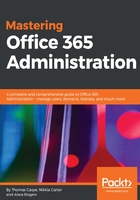
Groups
There are four types of groups within Office 365: distribution lists, security groups, mail-enabled security groups, and Office 365 lists. There are also shared mailboxes, but they have their own heading. We'll discuss the differences in Chapter 4, Administering Exchange Online – Essentials:

The Groups page
When you click on any group, a panel will open (usually to the right) displaying its properties, and you can edit many of the properties right there.
Distribution lists and mail-enabled security groups primarily live in Exchange, so their panels offer direct links to Exchange, to do further editing there, if desired.
Office 365 Groups and regular security groups are accessible via the Exchange administration site, but the Office 365 administration portal is equally competent at handling them, so Microsoft hasn't bothered including those links on their panels.
Within Office 365, you can edit:
- The name, description, ownership, and membership of a distribution list, and whether external senders are allowed.
- The name, description, ownership, and membership of a security group.
- The name, description, ownership, and membership of a mail-enabled security group, and whether external senders are allowed.
- The name, description, ownership, and membership of an Office 365 group, whether external senders are allowed, and whether senders should be automatically subscribed. It'll display your privacy settings—that is, is the group public or private—but you can't edit them after creating a group.
For a new group, there's a lot less functionality for creation than there is for editing, and particularly for the traditional types of groups; distribution, security, and mail-enabled security groups can't have owners or members defined during creation, and Office 365 Groups can only define the owner at creation, if you're using the administration portal.